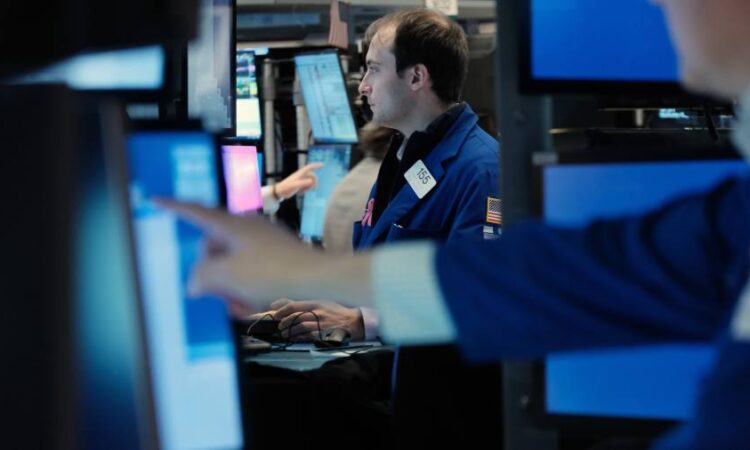
Latest news on ETFs
Visit our ETF Hub to find out more and to explore our in-depth data and comparison tools
Corporate bond funds bounced back into favour last month as investors appeared to put fears of a mushrooming banking crisis behind them.
Investors had pulled money from corporate bond exchange traded funds for a second straight month in March, even as government bond ETFs sucked in a record $34.9bn, as savers sought refuge from the banking turmoil that had engulfed Credit Suisse and a string of regional US banks.
However, April flows seem to indicate that investors have sounded the all-clear, even as regional US bank stocks continue to trade at depressed levels.
In a dramatic reversal of risk appetite, net inflows to corporate bond ETFs surged to a healthy $9.1bn in April, according to data from BlackRock, cancelling out the prior two months’ outflows. However, net buying of government bond ETFs slid to just $7.7bn, the second-lowest figure since January 2022.
“A lot of credit exposures saw more buying, so the asset mix shifted [from a safe haven play],” said Karim Chedid, head of investment strategy for BlackRock’s iShares arm in the Emea region.
In particular, Chedid noted a trend towards European investors snapping up European investment grade bond funds, a trade that is in line with BlackRock’s house view that old-world bonds now offer greater value than new-world paper.

The re-risking trend was also evident in the US, the epicentre of the banking crisis.
“In April, US investors were more willing to take on credit risk using fixed income ETFs due to greater confidence in the global economy,” said Todd Rosenbluth, head of research at consultancy VettaFi.
In particular, Rosenbluth noted that the iShares iBoxx $ High Yield Corporate Bond ETF (HYG) and SPDR Bloomberg High Yield Bond ETF (JNK) took in $2.7bn and $2.6bn respectively in April, while short-term Treasury ETFs such as the SPDR Bloomberg 1-3 Month T-bill ETF (BIL) and iShares 1-3 Year Treasury Bond ETF (SHY) incurred redemptions.
The latter was perhaps unsurprising, given that US investors were in the vanguard of waning appetite for government bonds, with net flows to US-domiciled sovereign bond ETFs plummeting from $28.7bn in March to just $2.6bn in April, compared to the more muted descent in their European-listed peers from $5.1bn to $3.7bn.
Rosenbluth also said there were signs of US investors starting to look overseas for higher-yielding instruments, with the iShares JPMorgan USD Emerging Markets Bond (EMB) drawing in a net $420mn.
Chedid noted this trend across a range of asset classes. “US investors definitely have more of an international focus, buying more Europe, emerging markets everything,” he said

Chedid believed this cross-border focus was partially driven by the weaker US dollar. In addition, “Europe’s economy has done better than expected”, he said, although he believed both the eurozone and the US are still “headed for a recession”.
In particular, he noted that US investors allocated more money to European equity ETFs for the third month in the past four, a surprise, given that such flows “have not tended to be sticky” in the past.
Chedid attributed the flows to European stocks’ outperformance of their US peers, with the Stoxx Europe 600 up 12 per cent since the start of September, three times the gain of the S&P 500.
“Europe has been outperforming the US since September, and it’s very rare for Europe to outperform for so long,” he added.
Overall, global flows to equity ETFs held steady at $26.5bn in April, from $26.1bn in March.
Rosenbluth noted that the Vanguard S&P 500 ETF (VOO) attracted $2.9bn of this, something he attributed to “renewed confidence that the corporate earnings season would be relatively strong”.
In Europe, funds investing in line with so-called “environmental, social and governance” principles topped the charts, with the Xtrackers MSCI AC World ESG Screened UCITS ETF (XMAW) and Xtrackers MSCI World ESG UCITS ETF (XZW0) gathering $600mn and $473mn respectively, according to data from TrackInsight.
Net flows to ETFs in total dipped, though, from $65.1bn to $53bn, driven by fixed income’s share slipping from $37.7bn to $25.2bn and flows to commodity funds flatlining after hitting $1.6bn a month earlier.
Latest news on ETFs

Visit the ETF Hub to find out more and to explore our in-depth data and comparison tools helping you to understand everything from performance to ESG ratings
Investors’ insouciance about the banking backdrop also shone through at the sector level. Not only did ETFs investing in financial stocks sport their fourth straight month of inflows — of $1.3bn — but US exposures led the way, seizing pole position from European financials.
Rosenbluth noted that the Financial Select Sector SPDR Fund (XLF) added just over $650mn of new money in April.
“The ETF provides some diversification with a mix of large-cap banks, insurance companies and capital market firms,” he said.
“There are investors out there buying the banks,” said Chedid. “There is a sense we have turned the corner on this, ie it’s not systemic, not that there can’t be more [bad] headlines.”






